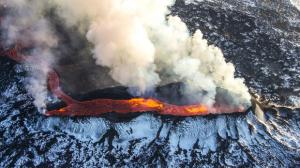In 536, most of the Earth was plunged into darkness for 18 months when a mysterious fog enveloped Europe, the Middle East, and parts of Asia. This fog blocked the sun, causing the temperature to drop suddenly, food crops and later humans were unable to survive. This was the darkest period in history.
But it wasn’t until 2018 that researchers found the cause of the deadly smog. According to a report in the scientific publication Antiquity , in early 536 there was a volcanic eruption in Iceland , which caused ash to cover the Northern Hemisphere and create a fog like “hell” “ . Just like the eruption of Mount Tambora (Indonesia) in 1815 – the deadliest volcanic disaster ever recorded, the event in Iceland in 536 was enough to cause a sudden change in climate and cause crop failure, famine all over the world.

Volcanic eruptions in Iceland drag ash to cover the Northern Hemisphere and create a mist like “hell”. (Pictured).
So, how cruelly did 18 months of concrete darkness turn out? The Byzantine (Eastern Roman Empire) historian Procopius states: “The sun shone down like no warm rays all that year” . Historian Procopius also said: “man cannot avoid wars, epidemics and other calamities”.
These records were not taken seriously until the 1990s, according to history professor Michael McCormick from Harvard University. In that decade, researchers observed tree trunk rings in Ireland, and discovered that something anomalous was indeed happening around the year 536. Summer in Europe and Asia became more intense. 1.5 to 2 degrees Celsius colder, even China has seen snowfall. Later, science called the period in 536, after a volcanic eruption covered the sky, the period of “Late Ancient Little Glacier”.
“Things changed dramatically and overnight,” explains Professor McCormick. “Humanity has experienced many scenes of mourning.”
Cassiodoris – a Roman politician – reported in the documents: “We saw the strange phenomenon that people did not reflect their shadows to the ground even at noon “. In addition, he wrote that the Sun had changed to a gloomy blue, the Moon had lost its glow, and “all the seasons seemed to be mixed together”.

The geological research station in Colle Gnifetti (Italy) also helped scientists find out what happened around 536. (Photo: NE Spaulding/Antiquity).
And yet, those who managed to survive 536 had to endure the volcanic eruptions of 540 and 547, which took a long time for the Northern Hemisphere to recover. “The post-ancient Little Ice Age began in the spring of 536 and lasted until 660 in Western Europe, and in Central Asia it did not end until 680,” said Professor McCormick.
The year 536 marks the beginning of the most extreme time in human history. Due to the cold climate and raging famine, the European economy suffered a severe recession. In 541, the plague broke out again and claimed the lives of a third, even half of the population of the Eastern Roman Empire.

The first plague, which occurred around 541-542, was an extension of a series of catastrophes in 536.
According to Earth and climate scientist Professor Andrei Kurbatov at the University of Maine, there are probably many new volcanic eruptions that have caused such a thick fog, but researchers say concrete evidence has not yet been found. However, they still believe that the year 536 is extremely scary, causing millions and millions of people to fall into a dead end and the scene is like the end of the world. However, humans can still overcome and thrive to this day, ie 1484 years have passed.

